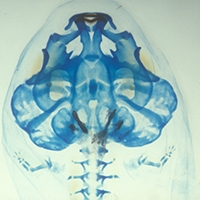Citation:
| 4.12 MB |
Date Published:
JanAbstract:
Direct development in amphibians is an evolutionarily derived life-history mode that involves the loss of the free-living, aquatic larval stage. We examined embryos of the direct-developing anuran Eleutherodactylus coqui (Leptodactylidae) to evaluate how the biphasic pattern of cranial ontogeny of metamorphosing species has been modified in the evolution of direct development in this lineage. We employed whole-mount immunohistochemistry using a monoclonal antibody against the extracellular matrix component Type II collagen, which allows visualization of the morphology of cartilages earlier and more effectively than traditional histological procedures; these latter procedures were also used where appropriate. This represents the first time that initial chondrogenic stages of cranial development of any vertebrate have been depicted in whole-mounts.Many cranial cartilages typical of larval anurans, e.g., suprarostrals, cornua trabeculae, never form in Eleutherodactylus coqui. Consequently, many regions of the skull assume an adult, or postmetamorphic, morphology from the inception of their development. Other components, e.g., the lower jaw, jaw suspensorium, and the hyobranchial skeleton, initially assume a mid-metamorphic configuration, which is subsequently remodeled before hatching. Thirteen of the adult complement of 17 bones form in the embryo, beginning with two bones of the jaw and jaw suspensorium, the angulosplenial and squamosal. Precocious ossification of these and other jaw elements is an evolutionarily derived feature not found in metamorphosing anurans, but shared with some direct-developing caecilians. Thus, in Eleutherodactylus cranial development involves both recapitulation and repatterning of the ancestral metamorphic ontogeny. These modifications, however, are not associated with any fundamental change in adult morphology and cannot at this time be causally linked to the evolutionary success of this extraordinarily speciose genus.
Notes:
Gy542Times Cited:75Cited References Count:69






